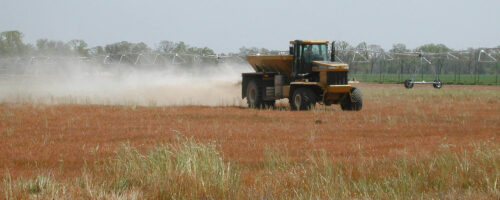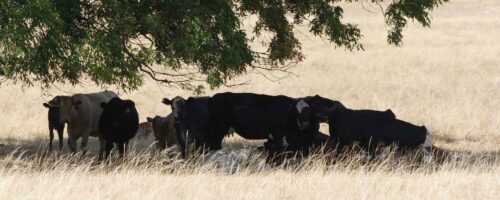Ryegrasses are productive, high quality cool season forages that are either perennial or annual in their growth. The perennial ryegrasses are grown throughout much of the midwestern and northern U.S. for pasture and turf. The use of perennial ryegrass in the southern U.S. is limited by the lack of persistent and productive varieties. Perennial ryegrass is sometimes used in the mid- to upper South as an annual because it is more winter hardy than annual ryegrass.
Annual ryegrass is adapted to the southern U.S. and is grown widely from the Atlantic coast westward to Oklahoma and Texas and southward to the Gulf of Mexico. Annual ryegrass is also planted to a limited extent in southern Kansas and eastward. Annual ryegrass is often used with a perennial warm-season grass, especially bermudagrass, to extend the grazing season. Annual ryegrass has also been used to extend the grazing season in winter small grain mixtures as well. Annual ryegrass can also be used as a spring planted grass in the upper South and Midwest that provides high quality grazing well into summer.
Annual ryegrass was grown successfully along the Gulf Coast as early as the 1940’s. These early plantings suffered from crown rust and expansion northward was limited by susceptibility to freeze injury. Crown rust is usually limited to regions within 100 miles of the Gulf of Mexico. The presence of reddish-orange (rust) colored blisters on the top of ryegrass leaves indicates that the plant is infected with crown rust. Eventually the leaf yellows and dies. Mild temperatures and heavy dew favor development of crown rust.
In 1958, the Texas Agricultural Experiment Station released the rust resistant variety, Gulf. Shortly thereafter Florida and Mississippi released rust resistant varieties. All of these varieties are still available today; however, many of the new varieties have improved yields and are less susceptible to freeze damage. Marshall was released as the first variety with improved cold tolerance and has served as the source of cold tolerance for many of the newer varieties. Marshall is among the most cold tolerant annual ryegrass varieties commercially available today.
Annual ryegrass is adapted to a wide range of conditions. It grows well on soils ranging from poorly drained clays to deep sands. However, production of annual ryegrass on sands is not as great as on heavier textured soils except under higher rainfall. Ryegrass will grow in areas receiving 20 inches of rainfall, but production is much greater in higher rainfall areas. In northern Texas and south central Oklahoma the best ryegrass production area is east of I-35. However, annual ryegrass can produce well in many years from southwest Oklahoma north to Kansas in rainfall belts of 25 inches or more. Ryegrass will also grow on acid soils, although growth is limited when the soil is below a pH of 5.5.
Annual ryegrass is planted by overseeding warm-season perennial grasses such as bermudagrass to provide grazing earlier in the spring or late winter. Annual ryegrass is also widely planted with small grains to extend the grazing season into late spring or early summer. Given adequate spring moisture and cool temperatures, annual ryegrass will remain productive into late May or mid-June. In the northern portion (Oklahoma and north Texas) of its adaptation, overseeded annual ryegrass produces little forage in the fall. Annual ryegrass is sometimes planted in mixtures with clovers to provide earlier grazing and reduce the potential of bloat from the clovers.
Seed of annual ryegrass will germinate in most fall and spring months when night temperatures are below 75°F. However, the best time to plant for optimum forage production is September and October in fall and in January to March in spring in southern Oklahoma.
Early plantings have the risk of germinating with a small rain shower and then not receiving enough rain for establishment. On the other hand, cooler temperatures limit fall forage production from late plantings.
Seeding rates of annual ryegrass range from 20 to 30 lb. per acre. The lower rate is suitable for broadcast planting with a small grain while the higher rate should be used when overseeding a competitive warm-season grass such as bermudagrass. When planting with a small grain the ryegrass seed should not be drilled with the small grain seed as it is a small seed and therefore sensitive to planting depth. Ryegrass seed is best planted in these mixtures by broadcasting.
When overseeding bermudagrass the existing sod should be grazed short or disked lightly to set the bermudagrass back before planting. Whichever annual ryegrass system is used, dragging or rolling to ensure that the ryegrass seed is in contact with the soil is a good practice. Overseeding bermudagrass with annual ryegrass reduces production from the bermudagrass in the spring.
Annual ryegrass is responsive to nitrogen fertilizer. When planted in mixtures with small grains on a prepared seedbed, nitrogen can be applied at or before planting. However, when overseeded on a warm-season grass sod, application of nitrogen can be delayed until after frost has reduced the competition from the warm-season grass. Nitrogen can be applied in split applications, while any phosphorus or potassium recommended by soil test should be applied at planting. Split application of the nitrogen generally leads to a more uniform distribution of forage production. Application of topdress fertilizer to annual ryegrass in the one to two leaf stage should be avoided if possible to prevent salt damage to the seedling.
Annual ryegrass is tolerant of frequent and intense grazing. When planted in mixes with small grains the small grain component should be “grazed out” to release the ryegrass. Recommended grazing management is to not graze shorter than two to three inches and allow a recovery period of three to four weeks during the active spring regrowth period. Remember that growth of the annual ryegrass will vary between regions, during the growing season, and from year to year.
Be flexible in your stocking rate, either by varying animal numbers or feeding supplemental hay. A strategy to use with cows is to limit graze the annual ryegrass pastures. Dry cows can be allowed access to the pasture every third day and wet cows every second day.
The ability of annual ryegrass to reseed itself is evident as we drive down the roads or see it in pastures that have not been recently seeded. Annual ryegrass can be managed to reseed under grazing with proper management.
The Noble Research Institute Pasture Demonstration Farm has a bermudagrass paddock that has been successfully managed for volunteer stands of annual ryegrass for 18 years. Removal of grazing animals when the ryegrass begins flowering is the best way of ensuring that the stand reseeds. On fields where it is the first crop of annual ryegrass it can be seeded at a lower rate the following year to develop a full stand.
Once a seedbank is developed in the soil, all that is needed to continue with ryegrass is disturbance of the soil in fall (mid-August in southern Oklahoma) by grazing the warm-season grass short and/or disturbing the sod by lightly disking.


Comment